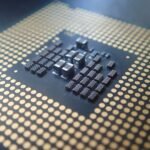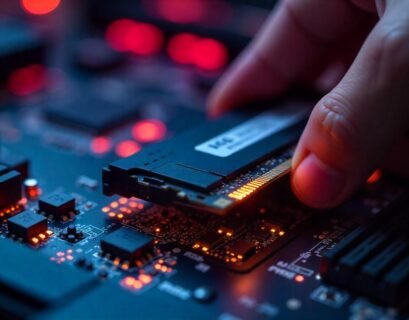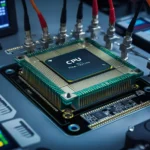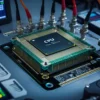The Central Processing Unit (CPU) is often heralded as the brain of the computer, handling instructions from both hardware and software. As the crucial component that drives performance, a deep understanding of its inner workings, recent innovations, and future trajectory is vital for technophiles, professionals, and everyday users alike. In this article, we will embark on a journey through the architecture of CPUs, explore industry advancements, glean insights from leading tech companies, and finally look towards the horizon of computing in the years to come.
Understanding the CPU: A Brief Overview
At its core, the CPU is responsible for interpreting and executing instructions. It takes input from various peripherals, processes it based on a set of instructions called programs, and sends the resulting output to other devices. The CPU operates in cycles, fetching instructions from memory, decoding them, executing the commands, and writing back the results.
Most modern CPUs comprise several key components:
-
Arithmetic Logic Unit (ALU): This component handles all arithmetic and logical operations, performing calculations critical to program execution.
-
Control Unit (CU): The control unit orchestrates operations within the CPU, directing the flow of data between the ALU, registers, and memory.
-
Registers: These are small, high-speed storage locations within the CPU that hold temporary data and instructions.
-
Cache Memory: This ultra-fast memory stores copies of frequently accessed data. Modern CPUs often have multiple cache levels (L1, L2, and L3) for optimized data retrieval.
- Bus Interface: This connects the CPU to other components such as RAM and storage, facilitating data transmission.
CPU Architecture
The architecture of a CPU can be divided into two dominant categories: CISC (Complex Instruction Set Computing) and RISC (Reduced Instruction Set Computing). CISC allows for a more extensive set of instructions, making programs typically shorter. In contrast, RISC utilizes a smaller set of instructions, enabling faster execution cycles through a more straightforward approach to instruction processing.
The advent of multi-core processors has revolutionized CPU design. These CPUs contain multiple independent cores on a single chip, allowing for parallel processing—simultaneously executing multiple threads of execution, thus significantly enhancing performance, particularly for tasks designed to leverage multithreading.
Latest Innovations in CPU Technology
The field of CPU technology is dynamic and continuously evolving. Below are some of the groundbreaking advancements shaping today’s computing landscape.
1. Miniaturization and Fabrication Technology
Moore’s Law, which predicts the doubling of transistors in a dense integrated circuit every two years, has driven the miniaturization of CPUs. Today’s cutting-edge processors utilize processes as small as 3nm, allowing for higher performance and improved energy efficiency. Companies like TSMC and Intel are at the forefront of developing smaller and more efficient transistors.
2. Hybrid Architectures
Hybrid architecture CPUs combine high-performance cores (P-cores) with energy-efficient cores (E-cores). Intel’s Alder Lake architecture, for instance, implements this design by balancing workloads across different core types. This allows the CPU to optimize power consumption without sacrificing performance, especially under varying load conditions.
3. Integrated AI Capabilities
As artificial intelligence (AI) and machine learning applications gain traction, CPUs are evolving to incorporate specialized processing units such as Neural Processing Units (NPUs) directly into their architecture. These innovations allow for specialized task handling, improving response times and computational efficiency for AI-related tasks.
4. Advanced Cooling Solutions
As CPU performance increases, so does thermal output. New innovations in cooling technologies, such as liquid metal and vapor chamber cooling, offer solutions to effectively dissipate heat, extending the lifespan of CPUs and improving performance.
5. 3D Chip Stacking
This approach allows manufacturers to vertically stack dies, thereby increasing the density of transistors within a given footprint. 3D chip stacking can enhance performance by reducing the distances between components, leading to faster data transfer speeds and reduced latency.
Industry Insights
Key Players and Market Trends
Leading companies such as Intel, AMD, and ARM continue to shape the CPU landscape with their respective innovations. AMD’s Ryzen and EPYC processors have highlighted the potential of multi-core architectures, capturing substantial market share from Intel in consumer and enterprise markets. Meanwhile, ARM’s efficient architecture has transformed the mobile and embedded markets, offering a competitive alternative to traditional x86 CPUs.
The Rise of Quantum Computing
Quantum computing poses a potential quantum leap beyond current CPU technology, leveraging the principles of quantum mechanics to process information in fundamentally different ways. While still in its infancy, companies such as IBM and Google are pursuing quantum dominance, illustrating the limits of classical computing and the potential to solve complex problems that were previously untouchable.
Software Optimization
As CPUs evolve, software needs to keep pace with architectural shifts. The development of programming languages and frameworks that optimize multi-core usage, such as OpenMP and MPI, is essential. Additionally, compilers are increasingly designed to exploit specific CPU features, further enhancing performance.
Future Outlook
The Shift to Heterogeneous Computing
The future of computing is leaning towards heterogeneous systems, integrating different types of processing units (CPUs, GPUs, FPGAs) to create robust and versatile computation environments. This architecture will allow for more efficient task allocation, increased productivity, and reduced power consumption.
Energy Efficiency Challenges
With computing power continuing to grow, energy consumption remains a critical concern. Future CPUs will need to prioritize energy efficiency while maintaining performance. Approaches such as dynamic voltage and frequency scaling (DVFS) and energy-harvesting technologies may provide avenues for achieving sustainable computation.
Introduction of AI-Driven CPUs
The integration of AI within CPU architecture will continue to rise, resulting in increased adaptability and learning capabilities in real-time. With the explosion of data generated globally, CPUs that can process and learn from this data on the fly will be at a premium.
Advancements in Security
As CPUs evolve, so too do the sophistication of cyber threats. A significant focus will be on enhancing security features within CPUs. Innovations such as hardware-based security modules and secure enclaves are already being developed to protect sensitive information and prevent unauthorized access.
Conclusion
The Central Processing Unit is the indispensable engine behind modern computing, continually evolving in response to technological advancements and market demands. Understanding the mechanics of CPUs—coupled with awareness of contemporary trends and future forecasts—offers valuable insights for users, developers, and technologists alike.
As we move deeper into the era of heterogeneous computing, hybrid architectures, and AI-infused systems, the performance of CPUs will remain a focal point for enhancing our technological landscape. Balancing demands for greater performance with energy efficiency, robustness, and security will be paramount in ensuring that computational advancements keep pace with human needs and aspirations.
In the perpetual race for more powerful, efficient, and intelligent computing solutions, the CPU stands at the frontline, tirelessly processing and driving the innovations that power our digital world. The journey inside the mind of your computer continues, with every pulse and pitch of silicon telling a story of ingenuity, potential, and the promise of what’s next.
This article offers a comprehensive overview of CPUs, technical innovations, industry insights, and what the future may hold, making it an essential read for anyone vested in computing technology.


















